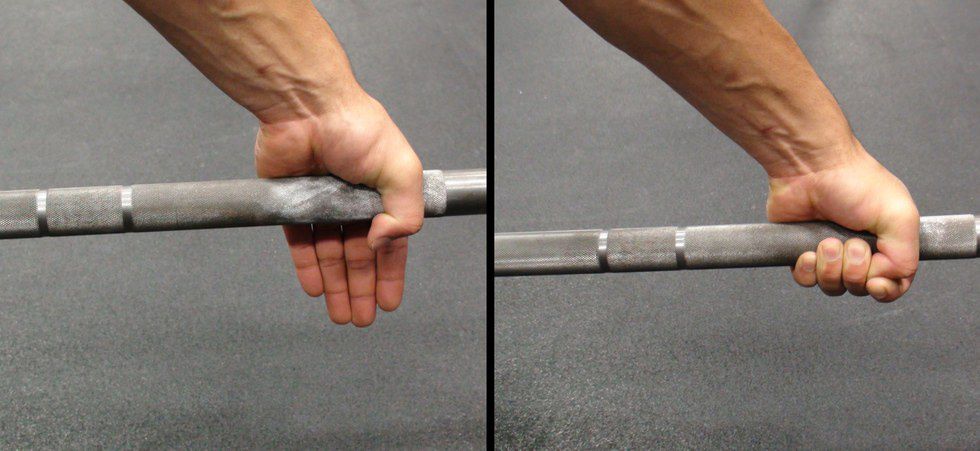The snatch is an Olympic movement that is used by athletes to grow stronger and faster. The snatch is unique in the world of lifting because it is an exercise that moves a weight from the ground to overhead in one quick motion. The snatch is a complex exercise that should be done under the supervision of a coach. Like all Olympic movements, the snatch should never be done for reps higher than four or five. High reps of a complex movement combined with fatigue results in injury. Here are some tips and tricks to help with performing the snatch.
Your snatch grip is much wider than a grip you would use to a clean, deadlift, row, or any similar movement. The width of your snatch grip should be about equivalent to the length from one elbow to the other when you raise your arms to shoulder height. Another way to gauge your snatch grip is to hold the bar at your waist. When the bar is at your waist and both arms are outstretched then you have your snatch grip.
The snatch, like the clean, is performed with a double overhand grip. You can snatch while wearing straps, but straps aren’t allowed when competing. A popular grip that a lot of Olympic weightlifting athletes use is called a hook grip. To do this, grab the bar like you normally would with a double overhand grip, but trap your thumb underneath your first and second fingers. This can be a bit uncomfortable to get used to but over the long term, it is an effective way to keep pulling heavier weight without using straps.
Similar to progressing the clean, you can start to learn the snatch by using a PVC or empty bar. Start in the power position with the bar at your waist. Practice pulling the bar overhead in one motion as you drop into a ¼ squat. Make sure to keep your arms straight as you catch the bar. If you are competing in weightlifting and you snatch a bar but your arms bend and then re-straighten when the bar is overhead you will get called for a press-out and the lift won’t count.
After mastering the power snatch from the power position, you can progress to a hang snatch plus a power snatch. Start again in the power position, and then slowly slide the bar down your legs as you get into the hang position. From there, pull the bar back up and overhead. Make sure to keep the bar close and keep your elbows up as the bar passes your chest.
After becoming comfortable with a hang snatch, you can progress to a hang snatch plus an overhead squat. The overhead squat can be very difficult to perform, especially if you have a lot of mobility issues. It is also often used as a diagnostic tool to evaluate people on their mobility and deficiencies. With practice, the overhead squat is a great tool to master to grow stronger and improve mobility.
When pulling from the floor make sure that your first pull is never faster than your second pull. This can cause the bar to travel farther away from your body and you can miss the lift. Also, make sure that your hips and shoulders rise at the same time as you pull the bar off the ground. If your hips rise too quickly you lose the power in your legs and start to pull with your back alone.
Accessory exercises for the snatch include the snatch grip deadlift which is a great exercise for strengthening the back. The snatch grip deadlift is performed the same as a regular deadlift, except the bar is pulled with a wide snatch grip. It is important to keep your chest up during the snatch grip deadlift because the wider grip tends to pull your shoulders forward and chest in.
Another accessory lift for the snatch is the sots press. It is a behind the neck press with a snatch grip that can be performed both standing up or in the bottom position of the snatch if possible. It is good for gaining strength and becoming comfortable with the bottom position of the snatch.
The last good snatch accessory exercise is the snatch balance. To perform this advanced exercise start with the bar behind your back with a snatch grip. Create some upward momentum as you bend your knees and then drive up against the bar. Push up against the bar as you simultaneously drop under the bar. You should finish the exercise in the bottom position of the snatch with the bar solidly overhead with arms extended.
To safely get out from under a missed snatch push against the bar in one direction and move your body in the other direction. Always pay attention to your body and how it feels when performing any exercise that involves moving heavy weight overhead.
Getting better at the snatch will transfer over to also improving the clean and jerk. With practice over time, the snatch can become and valuable tool in your workout repertoire to improve power, strength, speed, and mobility. Plus, it looks pretty cool throwing up 200 pounds from the ground to overhead in a matter of seconds.



















